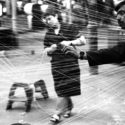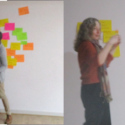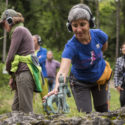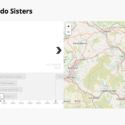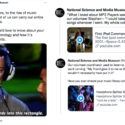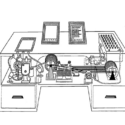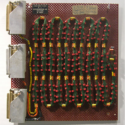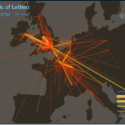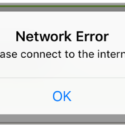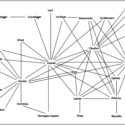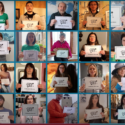Surfacing multiple perspectives on keywords for the Congruence Engine; embracing multiplicity, interdisciplinarity, and mutual learning
Article DOI: https://dx.doi.org/10.15180/221810
Abstract
This article explores collaborative conversation as a method to surface multiple perspectives on community engagement and forms of knowledge creation in the Congruence Engine project. Our exchanges naturally converged around four main areas: the multiple meanings of the term ‘community’ and the nature of these relationships; the modes and spaces for engagement; the different nature of knowledge emerging from these interactions; and, finally, a series of practical issues and challenges that can act as potential barriers. The article also reflects on the opportunities of dialogic writing to enable participatory, inclusive and polyvocal approaches in the development of a national collection.
Keywords
Community Engagement, conversational writing, digital sustainability, knowledge co-creation, online cultures, participatory heritage practices, remixing
Introduction
https://dx.doi.org/10.15180/This paper came out of a desire to explore ways of surfacing the multiple perspectives that the postdoctoral research fellows working on the Congruence Engine project are bringing to their work. The Congruence Engine is a three-year funded project, supported by the Arts and Humanities Research Council as part of their ‘Towards a National Collection’ programme. The project seeks to use a variety of digital tools and techniques to understand what type of new historical research might be possible through connecting different cultural heritage collections related to industrial history (chiefly through the themes of Textiles, Energy and Communications). We use an action research methodology to experiment with ways of linking different collections, and further understanding what social and technical infrastructures might be required to support the development of a national collection. The research fellows sit across different aspects of the project; Arran Rees being the research fellow for the action research project methodology, Anna-Maria Sichani addressing the digital humanities questions for the project, and Stefania Zardini Lacedelli being the fellow for the Textiles historical theme, with a focus on sound-based sources across the project. We chose to use keywords to identify some of the different elements of the project that are of interest to us and decided that rather than just write about concepts that are important to us as individuals, we would all respond to the words chosen by each other. Our idea is that although we all have areas of expertise and experience, we also have our own understandings and interpretations of the wide-ranging areas the project intersects with. We want to avoid Congruence Engine being a project with siloed expertise, instead offering the concept of mutual learning and exchange, whereby even the most experienced of historians, digital designers, curators or action researchers can learn something about their own field through the viewpoint of others.
There is no way we could talk about using keywords without acknowledging the work of Raymond Williams and his 1976 publication Keywords (with a second edition in 1983), tracing the changing nature of words and language. Williams’ seminal work argued that to understand the meaning of a word, you needed to look at its history and use over time. However, whilst we nod towards Williams’ work in highlighting the complexities in the meanings of words, we are looking to explore the plurality and evolution of meanings of words – not looking for singular authoritative meanings, but embracing and celebrating the multiplicity of interpretations, perspectives and understandings. The primary inspiration for our approach came from Anna-Maria’s’ reading of the recent Uncertain Archives publication (Thylstrup, Agostinho et al, 2021). In it, multiple authors from different disciplines attempt to unpick the implications of big data and archives by using non-traditional keywords. The publication contains 61 keywords all written by different authors who present a discourse on their keyword from their own perspective. Where our approach differs is that we decided to respond to each other’s keywords too – further highlighting the potential richness of interdisciplinary work.
The keywords featured in this piece are ‘People’, ‘Improvisation’, ‘Memory’ and ‘Network(s)’. They were chosen by the original authors of this piece as words that felt relevant and important to them for their work in the Congruence Engine. Each keyword features a longer thought piece by the author who proposed the keyword which is followed by responses from the co-authors. Unfortunately, there are only three authors in this piece. This article is dedicated to the memory of our late colleague Cameron Tailford. Cameron chose ‘People’ as his keyword, many months before he heartbreakingly passed away. We have the greatest respect for Cameron’s thoughts and contributions to the work of Congruence Engine, and although we sadly do not have any written words from him on ‘People’, we wanted to acknowledge the importance of this keyword to his work, and therefore the work of the project. We have each written a small personal response to ‘People’, knowing that is what Cameron wanted us to think about, but do not pretend to know the wonderful insights he would have, no doubt, been able to add to our work.
People
https://dx.doi.org/10.15180/221810/002Arran’s response
We know from Cameron’s work on the project that he was deeply concerned with surfacing people and their stories within histories of industry. As someone who cut their teeth in social history museums, I am totally on-board with the centrality of people. We are inherently social beings – even the ones of us that tend towards more social introversion than extroversion! Whether we are thinking about historical questions around the development of the textiles industry in the seventeenth century, observing the ways in which curators and archivists go about using collections material to undertake their research, or reflecting on the dynamics of interdisciplinary work – paying attention to the lives, attitudes and social processes of people is a central concern.
As a co-facilitator of the action research in this project, I am inclined to thinking about the social processes of us working together as a team. Within this, we might want to consider the role of collegiality, humour and social relationships in a large dispersed and interdisciplinary project like Congruence Engine. In my doctoral research I began exploring the role of humour in creating a shared sense of purpose, in developing social relationships, and in negotiating power. Philosopher of humour, John Morreall, argues that comedy and humour have several, often overlooked affinities with research. These include the desire to look at new perspectives, think critically and creatively, ask lots of questions, and to challenge traditions, conformity and authority (Morreall, 2014, 2020). All of these, as well as social relationships and shared notions of purpose seem important to a research project like ours, especially when we think about the role of improvisation in our action research too.
Janet Holmes and Meredith Marra explain that workplace humour develops jointly constructed jokes that can resonate across the team (2002). However, when we think about a research project like Congruence Engine, the team is coming together from disparate places, contexts and disciplines. Whilst there is no reason collegial bonds, created through shared humour exchanges cannot be developed, Holmes reminds us that workplace humour is inextricably context-bound, and that insider jokes that can appear obscure and opaque to outsiders (Holmes, 2000, p 159). As we come together and bond as a team of people, especially one that works in a primarily digital way, we need to acknowledge that we all come from places where our context-bound workplace humour may have developed differently. It is important to recognise the power relations in some uses of humour – it has the potential to shut down conversations rather than safely engage them. The Congruence Engine, with its historic themes of Textiles, Energy and Communications will encounter and actively engage with sensitive histories and ongoing contemporary issues. It is essential that as we develop our collegial bonds, and potentially begin to develop jointly constructed context-bound jokes, we do not inadvertently enforce notions of the killjoy if someone does not want to take part in joking (see Ahmed, 2010: 2),[1] and ensure that any instances of collegial humour are not resulting in unintended barriers to getting involved.
Stefania’s response
I remember talking with Cameron about people being the very heart of Congruence Engine. His attention and sensibility towards individual lives and stories will be one of his enduring legacies in the project. In our investigation on the interaction between human, data and machines, ‘People’ is always at the centre: we aim to create a ‘social machine’ (see Shadbolt et al, 2019)[2] which allows people to make the connections that are meaningful to them, depending on their interests, passions and personal stories (Shadbolt et al, 2019). One of the concepts emerged at the very beginning of the project is that ‘We are not building a Congruence Engine: we, the project participants, are Congruence Engine’ (Boon, 2022). This highlights the key role every one of us has in shaping the research process with each individual’s unique perspective, experience and way of understanding the world.
The importance of personal dimension in museums has received increasing attention. Human-centred design has become a key approach in heritage practices (Mason and Vavoula, 2021), and it is prompting a rethinking not only of how the experiences are designed, but also what museums should collect. Museum collections do not exist on their own: they are created, preserved, shaped by people; they are interpreted and experienced by people. The objects themselves become alive in the very moment in which they are connected with a human experience. In my PhD research I reflected on the emerging need to create a more emotional and personalised approach to museum collections, using sound and music as a catalyst. This was one of the key insights from the #SonicFriday project I worked on at National Science and Media Museum. Throughout the summer of 2020, the #SonicFriday team invited online audiences and museum volunteers to share their memories of sound technologies on social media. Reflecting on the variety of stories, sounds, songs and feelings shared by people online, the museum team realised that ‘the objects magically come alive again’ and that ‘stories of usage are just as important as stories of invention’ (Zardini Lacedelli, Stack and Jamieson, 2021). The focus on people’s experience was so prominent that one of the themes developed in the project, Sounds of my Quarantine,[3] was not even related to a collection object, but emerged from the willingness to reflect on people’s sonic experience during the first Covid-19 lockdown.
People stories are also one of the key areas of investigation in the Congruence Engine project. In the first textile pilot, ‘Textile Voices’, we undertook a series of social history investigations to explore the personal experience of mill workers. We realised how sound-based heritage such as oral history can give us a deep insight into the life in the mill, helping us to contextualise not only historical events within life experiences, but also to capture embodied knowledge, attitudes, beliefs and feelings that are not always represented in museum collections. As Rob Perk and Tim Smith highlighted in the introduction of ‘Textile Voices’, ordinary people’s stories had never been written down. And yet, they are the only way to understand the impact of textiles on everyday life, and to ‘rescue the individual from the crowd and from the stereotype’, revealing a rich variety of experiences (Smith and Perks, 2006).
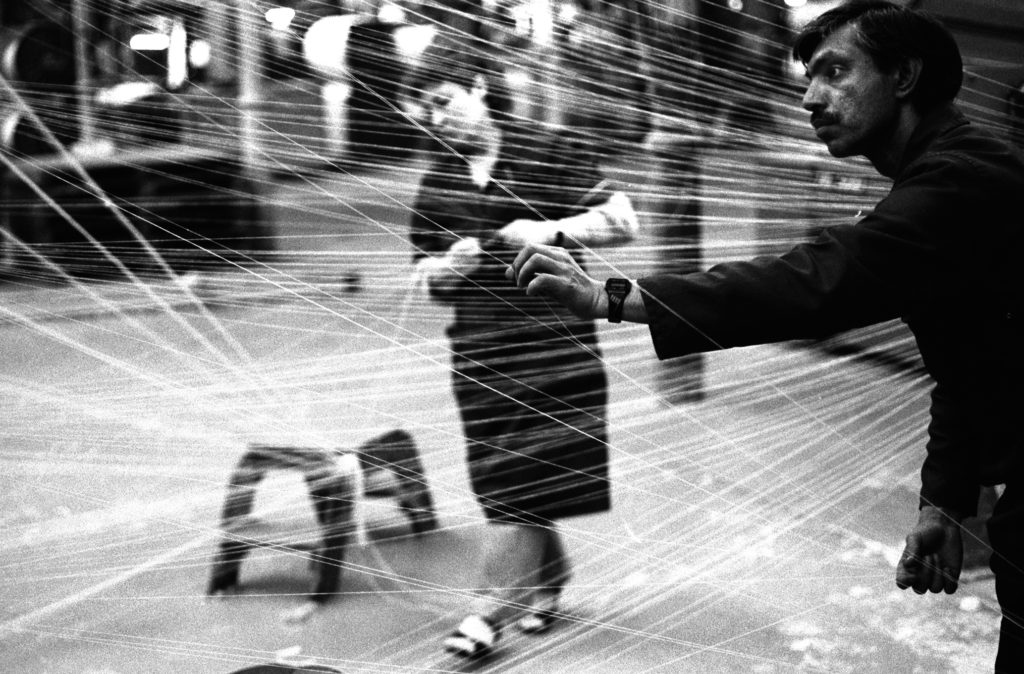
The centrality of ‘People’ in Congruence Engine is evident if we look at how this word connects the other words we have chosen in our article. It is the people at the heart of the Congruence Engine social machine, who will react, interact and open new, unexpected directions in the action research process. It is the people that create, share and preserve memories. And it will be the people who unlock the wealth of connections which will give life to our National Collection.
Anna-Maria’s response
People is a strange noun. It can be used as countable and uncountable, as a plural of person but can be used as a singular noun to refer to a population or particular community. People often come without names, bringing with them a collective identity and ethos. In other contexts, people’s names are intrinsically important, bearing with them important ordinary stories and remarkable legacies. It wasn’t until the late 1960s and 1970s that historical research embraced a dual interest in social history, with the growth of the Annales School, and ‘history from below’ and everyday people’s stories (microhistories) as a way of understanding historical momentum (see, for example, Carlo Ginzburg’s emblematic work Il formaggio e i vermi (The Cheese and the Worms) (Ginzberg, 1982).
Cameron had a genuine interest in and subtle eye for people. Since his PhD research and during his time in Congruence Engine he tried to shed light on the agents behind the events and institutions, on their lives, their stories, their experiences, their legacies. The Congruence Engine, after all, through various mini investigations, will focus on exploring people’s stories behind digital collections and assets, trying to decode their ideas, feelings and values. Interestingly enough, as part of my role as a Post-Doc Research Associate in Digital Humanities I am also embarking on an exploration of the ethics behind the collections, aiming to reveal the biases in the collections and in technological systems. I want to understand why and how certain (groups of) people and their legacies are omitted from cultural heritage collections and how this phenomenon is reinforced by technological choices and environments. In other words, once more, I am going to assess the politics around the noun people.
Improvisation
https://dx.doi.org/10.15180/221810/003Arran
What does it mean to improvise in a research project? To me, it feels like there is often a negative association, where people are forced to be creative with what they do because of a lack of resources, or through being ill-prepared. This association usually exists in a context that is organised and planned as discrete work packages, artificially demarcated as if each can be separated from each other with individual tasks, roles, and outcomes. However, in Congruence Engine, we are working with systemic action research (Burns, 2007, 2014), a method that is more than just a method; it is better described as a broad orientation towards seeing the world as inherently social, complex and interconnected. This is an orientation that accepts that is no real objective truth, but rather multiple perspectives and ways of knowing the world which we seek to better understand through undertaking actions, observing them, reflecting on what happened and learning from it (Reason and Bradbury, 2008). When we accept that we live in a messy, complex and interwoven world where personal lived experiences mesh with our work lives, and interact with ever changing social and political environments, then we might start to understand the benefits of improvisation as a core working practice.
The literature surrounding improvisation highlights its potential to enable divergent thinking and increase our capacity to deal with uncertainty (Felsman, Gunawardena et al, 2020); as a tool to support diverse and dynamic projects, companies and organisations (Cunha and Cunha, 2001; Vera and Crossan, 2004; Magni, Provera et al, 2010); and as a practice that supports the facilitation of complex and multidisciplinary projects (Freitag Granholt and Martensen, 2021). Most of the literature provides direct links back to theatrical or musical improvisation (or improv) and talks directly to the idea of applied improvisation – as an adaptation of improvisation in non-theatrical environments (Robbins Dudeck and McClure, 2018; Freitag Granholt and Martensen, 2021, p 3). Personally, I have tended not to make conscious links between theatrical improv, and the ways in which I improvise. However, I cannot escape how the tradition has influenced the work I do. I have always thought of my approach to improvisation much more along the lines of how Zenk, Hynek, Schreder and Bottaro describe it below – in a way that is implicitly linked to theatrical improv, but does not explicitly reference it:
The dynamics and complexity of the challenges of our work and lives result in a high number of unpredictable situations. The phenomenon of improvisation describes actions performed in the context of such situations that require people to find new, appropriate solutions in which no pre-planned actions or routines can be carried out (Zenk, Hynek et al, 2022).
My particular understanding of how improvisation is relevant to the Congruence Engine comes from this sense of navigating largely unpredictable situations through the action-focused inquiries that make up our action research project. A workshop facilitated by me might not include direct references to theatrical improv but it might be the sort of space where you are encouraged to hold uncertainty, and work in a way that a theatre improviser might find familiar, or – to use the work of one of the giants of systemic action research, Danny Burns – to develop an orientation towards accepting offers, to finding new opportunity spaces, and to following where the action takes you (Burns, 2007). This requires a broad openness to improvising as the context of the research changes around you.
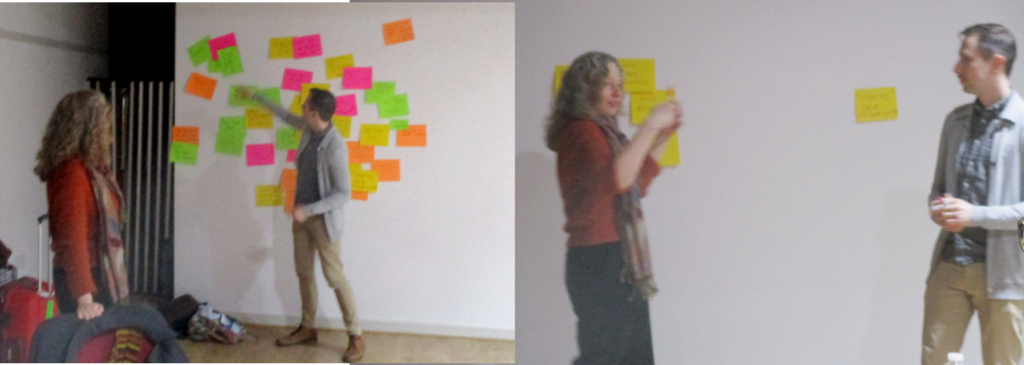
From early on in the project we realised that we were not building a Congruence Engine, but that we, the people working on and with the project, are the Congruence Engine. Whilst we are interested in questions that intersect historical and digital research, we are an inherently social project that requires us, as participants, to adapt and, yes, to improvise as issues and opportunities emerge. As we work within an interdisciplinary project like this, where we come from a variety of different professional backgrounds and hold different ontological approaches to our work, one aspect of our action research facilitation that is already proving integral to our ability to improvise is the ability to pay attention to what resonates with people. Resonance is highlighted by Burns as a key aspect of productive action research relationships; noticing what resonates provides a sense of what matters to people and how their own experiences relate to what is being discussed at the time (Burns, 2007, p 53). Picking up on that spark of energy when something resonates feels like an important part of improvising; it involves knowing when to abandon, or at least take a detour away from the current track and follow a newly emerging path. I am not going to pretend that we haven’t already improvised and got it wrong, and I am sure the complexity of our contexts will catch us out a few more times along the road. Despite this, I find that uncertainty, and the nimbleness of an approach that embraces improvisation, exciting and energising.
I’ll finish with one of my favourite quotes, one that helped me enormously as I improvised and muddled through previous action research work:
If you think you know what you are doing as an action researcher, [that] you have it comfortably in hand, you are not really doing it, [you] are not on a learning edge (Marshall and Reason, 2008, p 2).
Stefania’s response to ‘improvisation’
Like Arran, I feel that improvisation is energising and extremely productive in research. It is when we allow ourselves to depart from what we know that new horizons can open in front of us. I am also aware that it is not always an easy task, especially for museums which, in their nature, are conservative institutions and tend to rely on well-established practices and assumptions.
When I think of improvisation in the context of heritage institutions, there are three other words that come into my mind. The first is freedom. Improvisation implies freedom from well-known boundaries. When I was working in the a few years ago we challenged museum curators to re-imagine their practices outside their traditional ways of working.[4] In this case, the opportunity to operate in an ‘unbounded’ virtual dimension, which was very different from the traditional exhibition space, has given them the freedom to ‘go against the grain’. As they recalled in the focus groups at the end of the project, it was exactly the lack of consolidated ways of working that allowed them to imagine a new relationship with the audience, new narratives, new forms of heritage (Zardini Lacedelli et al, forthcoming).
The second is experimenting. When you allow yourself to enter the unknown, you need to be prepared to explore and test new things, and this also implies the opportunity to make mistakes. This was expressed very well by the name chosen for the digital space created in the Museums of the Dolomites project: Laboratory of Stories.[5] The word ‘laboratory’ recalls the traditional forges of blacksmiths, spaces where ‘you get your hands dirty’ (a quote from project participants) to produce something wonderful. The participants described this space as ‘a gym for their mind’: a place to learn and experiment with different languages and formats (Eid, 2021).
The third is creativity. Improvisation fosters the – often unexpressed – desire to unleash the imagination and generate new forms. Art, music, literature are all activities which nourish this human innate ability. Although museums have privileged a visual, scientific and rationalistic approach in the collection and display of objects, in recent years they have embraced more emotional, multisensory and creative perspectives in the interpretation of the collections and the design of the experiences (Dudley, 2010; Levent and Leone, 2015). In my PhD research, I have explored how the use of sound and music can foster this creative ability both in curators and audiences, using collaborative design methods to create new museum practices.
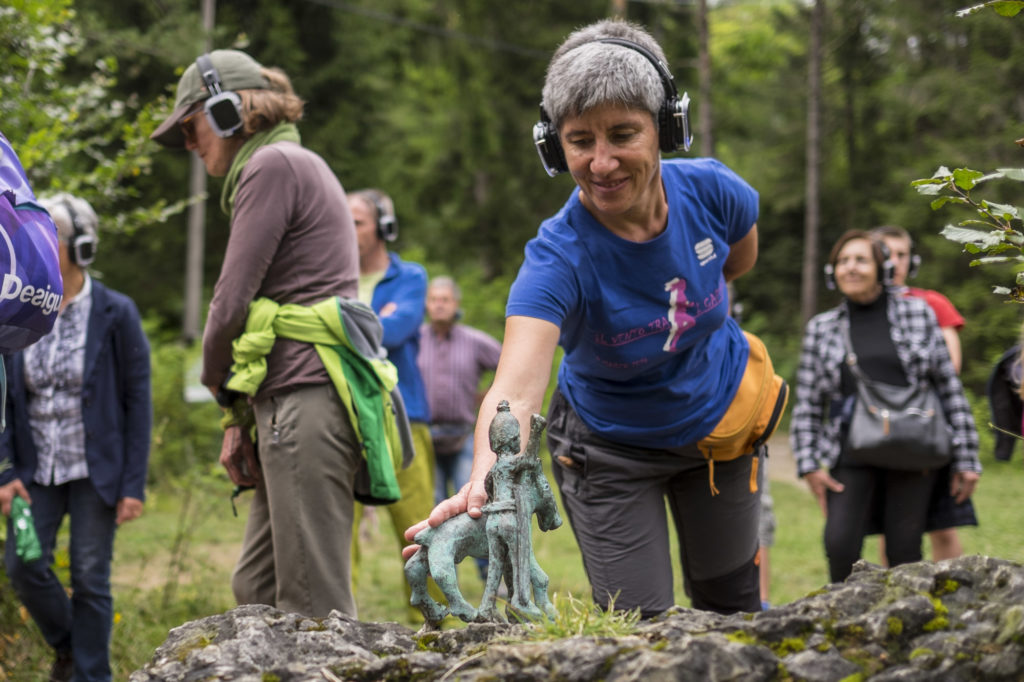
Anna-Maria’s response
Almost a decade ago when I first started working in Digital Humanities I was impressed by how much we can or have to improvise in our DH scholarly practice. Although Digital Humanities is a field and community of practice which is rigorously trying to define and structure its disciplinary presence and methodological repertoire, our everyday DH practice is embedded in improvisation, experimentation, flexibility in methods, tools, patterns of work, collaborations and workflows.
Navigating largely unknown datasets and assets, experimenting with new digital tools and methods or with challenging, unpredictable research questions, approaches and uncommon scholarly outputs, unconventional project settings and interdisciplinary teams, Digital Humanities practice force us to improvise in a creative way: we have to embrace the unexpected (Sayers, 2017).
However, improvisation in DH is not always easy or joyful: there are numerous challenging moments, futile battles and, of course, failures during this journey. For example, we are still trying to imagine and define ways to evaluate innovative digital scholarship outputs, to give adequate credit to their creators, and to improvise modes of work in order to ensure efficient collaboration with software engineers and systems and information architects. Interestingly enough, the 2022 Digital Humanities Research Hub seminar series at the School of Advanced Study focuses on ‘Reframing failure’, aiming to critically examine our understanding of failure within the Digital Humanities community. On the other hand, improvisation in DH is not only about defining an interesting action event, but presents an opportunity to reflect on practice. When facing an improvisation moment, we need to strategically and somehow creatively assess existing resources and risks, measure the impact and the goals of the endeavour, while leaving room for the unexpected to come. In the end, improvisation is not 100 per cent luck or freedom.
We are lucky to celebrate a similar culture of improvisation and experimentation in the Congruence Engine. Being a ‘Discovery’ project, the Congruence Engine team have embarked on a creative journey with interdisciplinary collaborations, and mini-investigations on multi-institutional industry history collections using innovative digital methods and tools, alongside a set of open, challenging questions around historical knowledge formation and information management. In these areas our improvisation competence is being constantly reassessed and redirected towards experimentation, excitement and failure, in equal doses.
Memory
https://dx.doi.org/10.15180/221810/004Stefania
The word ‘memory’ has always had a strong impact on both my research and personal life. Since I was a child, I have been fascinated by the way we create and share memories of our past, both as individuals and as part of a wider community. Objects, letters, diaries and photos belonging to the generations before us have been, for decades, the way we learn about our family past and where we leave traces of our personal story. At a collective level, museums, archives and libraries have preserved, for centuries, tangible and, more recently, intangible memories of the past of entire communities, passing them on from generation to generation.
The way we create memories has drastically changed in the last century. A variety of formats and media allow us, today, to record our life experiences; a phenomenon that, in cognitive studies, is defined as external representations of our memory (see Eliseev and Marsh, 2021).[6] This evolution was prompted by the technological revolutions of the twentieth century, which have multiplied the way we can create and share memories.
This has left its mark in our family memories. From the rare black and white photos of grandparents and great-grandparents, family albums have become richer and more colourful, documenting life stories, alongside the social transformations of the second half of the century. In the same period, sound and multimedia memories began to appear alongside visual and written records, thanks to the domestication of new sound and video recording technologies (Bijsterveld and van Dijck, 2009)[7]. At the turn of the century, these new forms of remembering contributed to what is described as ‘Memory Boom’ (Huyssen, 2003) and the ‘Mediatisation of Memory’ (Hoskins, 2009). The mobile phone has become our personal and social machine of memories (Reading, 2009), a machine that allows us to create, modify and instantaneously share tens of thousands of memories in the form of images, short videos, messages. Some of these new digital memories started to populate our personal profiles on blogs and social media, replacing the photo album in its function of storytelling and sharing. These online spaces allow us, today, to navigate in the world of others’ life memories, entering a dimension that was previously reserved for the closest networks of friends and family.
What implications does this evolution have on memory institutions? How is this changing the way in which museums, archives and libraries preserve and share the past?
The reflection on the role of memory and its evolution has given rise to a new transdisciplinary field: Memory Studies.[8] One of the most thriving debates in this sector concerns the relationship between the personal and collective way of remembering, between ‘individual memory’, ‘collective memory’, and ‘historical memory’ (Halbwachs, 1951; Yerushalmi, 1989; Crane, 1997; Nora, 1989; Anton, 2016).[9] Within this discourse, a new concept emerged at the beginning of the twenty-first century: ‘Digital Memories’. ‘The digital – Joanne Garde-Hansen, Andrew Hoskins and Anna Reading write – suggests that we may need to rethink how we conceive of memory; that we are changing what we consider to be the past; that the act of recall, of recollection and of remembering is changing in itself’ (Hoskins, 2009).
This rethinking of the concept of memory has shed a new light on the relationship between the personal and the public, and between the present and the past. The new digital memory, created and shared online, is described as a new hybrid form of private and public memory, where the present is remembered alongside the past:
Digital memories are not just from the past (wartime memories) but are continually made present to the audience, are not consumed memories (…) but produced by the audience (9/11 online memorials), and these memories are not simply shared and told (radio histories) but creatively constructed (digital storytelling). They may not even be historically significant memories but they are personally meaningful (Hoskins, 2009).
For its participatory nature, the concept of ‘memory’ strongly resonates with the new culture of convergence of digital media (Jenkins, 2013): unlike the ‘one-to-many’, authoritative and institutionalised approach that has characterised history, the production of memories relies upon personal and shared knowledge (Halbwachs, 1980).
These reflections lead to a series of fundamental implications on the future of memory institutions, at the same time offering new, interesting areas of experimentation within the Congruence Engine project.
First, curators and historians can rely on an incredible variety of forms and media to study and understand the past. In addition to the objects (which have dominated museum culture in the past) and written documents (which have been the main source for historical research) sounds, video recordings and other digital-born sources are nowadays a key part of museum collections and archives. Sound, in particular, has fostered a major shift in the perception of the past (Sterne, 2003).[10] The opportunity to collect not only tangible but also sonic memories of places, people and events has introduced a more sensorial, personal and emotional dimension of historical narratives. In Congruence Engine, we started to reflect on the opportunity to use these sources to connect collections, reflecting on what kind of information a sound recording of a textile mill or a protest song of industrial workers can provide.[11]
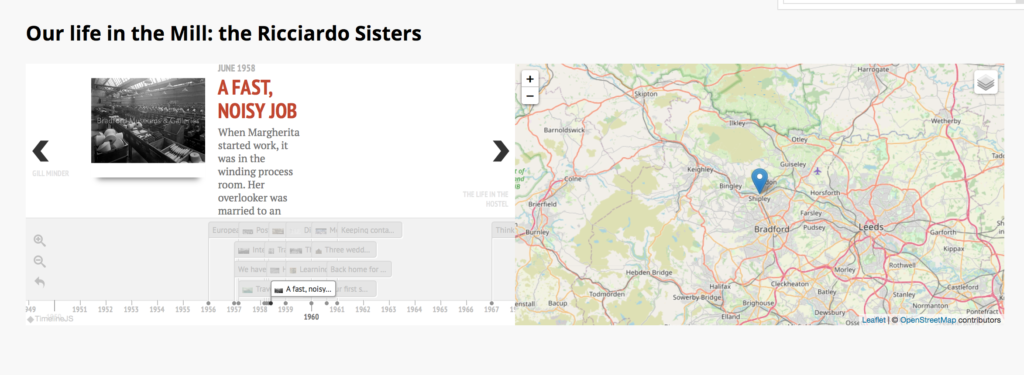
Secondly, collective memory practices developed by museums and archives are now intrinsically linked with personal memory practices. The possibility of creating and making autobiographical memories instantly accessible has taken away the power from the traditional forms of information dissemination: the news of the world is being replaced by the news of the self (Merrin, 2008). Consequently, museums have started to use social platforms not only as spaces for audience engagement, but also as places for the collection of digital memories, starting to reflect on new forms of heritage (Burkey, 2019; Boogh, 2020; Zardini Lacedelli et al, 2021). The exponential growth of autobiographical memories is also contributing to new forms of representation of the past, which are characterised by a greater personalisation of events, narratives and testimonies: the emphasis is shifting away from history towards small stories and microhistory (Laite, 2020).
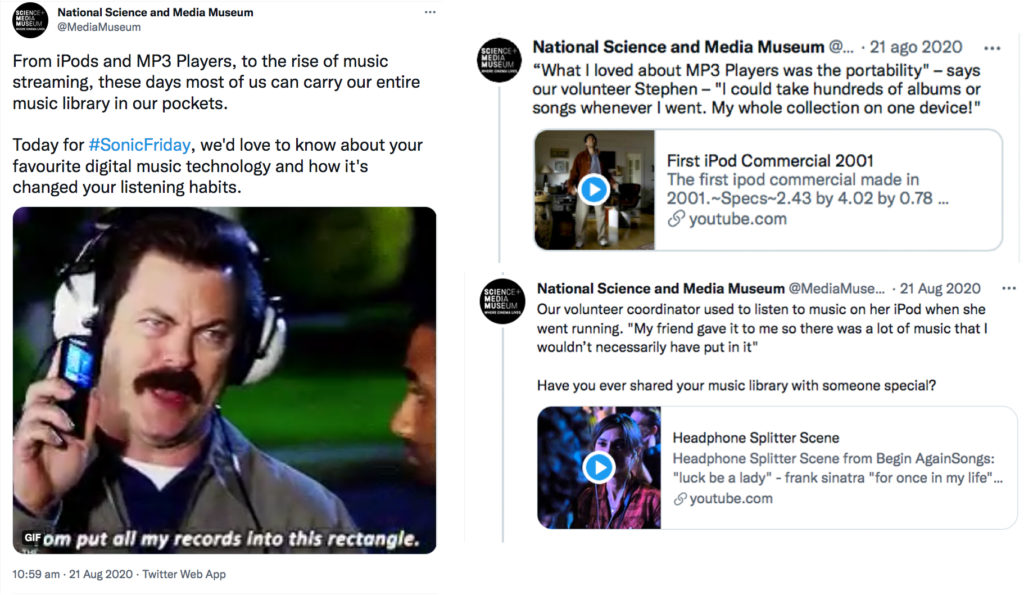
Finally, the evolution of memory urges us to reflect on its (apparent) counterpart: oblivion. The almost unlimited possibilities of creating memories provided by digital media have fostered a culture of data accumulation, where the risk is that we are no longer able to select what is important to us. Information loss is becoming one of the greatest fears of this century (Gleick, 1999), and yet it is an essential part of the very process of remembering. Memory, as Bartlett wrote, is a creative, subjective and dynamic faculty (Bartlett, 1932), which involves the selection of some information and the loss of others. Otherwise, the danger is thoroughly described by Borges in the story of ‘Funes, His Memory’: not being able to forget anything is equivalent to losing everything. Once upon a time, it was the task of history – to use Anna Comnena’s words – ‘to hold in a tight grasp whatever it can seize floating on the surface’ and ‘not allow it to slip away into the depths of Oblivion’ (see Comnena, 1969, p. 17).[12] The challenge we face today could paradoxically be the reverse. Deciding what, in this continuous, irresistible and infinite stream of data, we want to transform into collective heritage, and what we will let go.
Arran’s response
I completely agree with Stefania that memory is an important hook for heritage institutions; a personal memory makes history feel more relatable, it encourages visitors to empathise, it can evoke feelings of nostalgia. Where it is possible, memories provide a route into resonating with material from the past.
I used to work at the Museum of Cardiff (previously Cardiff Story Museum) and there, personal memories are used in the interpretation of museum objects in the gallery. This is a related but different practice from that of recording oral histories – the memories associated with objects in the collection can be entangled with that very object – often captured at the point of acquisition; or they can be prompted by the object and recorded on comment cards, through interactions at public events or through more formal interviews. These personal memories are used as direct quotes, in the first-person, with a name attributed (if the memory was not given anonymously), and objects can have more than one personal memory associated with them. Doing this is obviously only possible for objects that have been collected within living memory, but I suggest that this point of difference in how the museum presents the collection enables a sense of the people who interacted with the object before it was collected to remain alive (see Kavanagh, 2000; Black, 2011).[13]
Let’s take, for example, this lamp in the Museum of Cardiff collection:
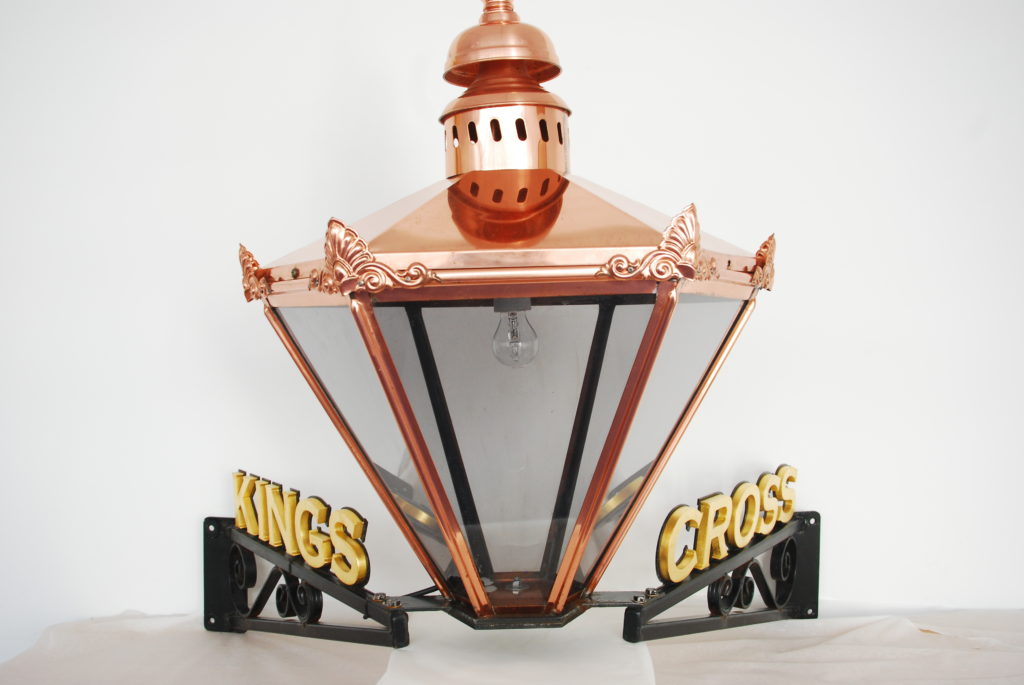
A traditional object label and catalogue record might look like this:
Copper, Victorian style lamp with ‘KINGS CROSS’, gold in colour, on a black metal bracket. This lamp used to hang above the entrance to the Kings Cross pub in the City Centre. The Kings Cross pub attracted the LGBTQ+ community from the 1970s until its closure in 2010.[14]
But using a personal story someone offered to the museum when they had a stall at Cardiff Pride in 2012, the label now features this:
Cardiff Kings Cross was my first experience of a gay night out. It was a lovely night and really opened my eyes to how open and accepting a gay night out in town can be. Shame that it closed.[15]
The addition of a personal memory adds a distinct perspective; it highlights that the Kings Cross was more than just a pub that ‘attracted the LGBTQ+ community’ – as if the LGBTQ+ community is one homogenous blob – it was a place where someone, an individual person, had their first night out in a queer space and felt safe.
It is important to acknowledge that whilst personal memories associated with objects does remove or, at least de-prioritise, the curator’s voice, it does not remove the curator’s power. The use of memory is still a curatorial strategy, one that takes some steps towards the non-authorial, but does not necessarily give up control over the narrative. Despite this, I would love to see more personal memories recorded alongside museum collections; not regarded as ‘community stories’ that sit alongside them, but as key aspects of the collection data that feature in interpretation labels, catalogue records, and form an active part of a lively and constantly evolving national collection.
Anna-Maria’s response
Memory brings the past into the present. Although recent scholarship has highlighted various theoretical perspectives on memory, from collective memory and identity formation (Halbwachs, 1980), cultural memory (Assman, 1995; Assman, 1999) to how our memory is shaped after the material turn (Bennett and Joyce, 2010), what has been regularly overlooked is how ‘memory’ has been used in the last sixty years in order to define techn(olog)ical devices of data or information storage. Following media historian and theorist Wolfgang Ernst’s suggestion to approach both archive and memory as purely technical practices of data storage (Ernst, 2004), I tried to trace the origin of memory as a data storage device in computer hardware and digital electronic devices context.
In 1945 Vannevar Bush in his article ‘As We May Think’ envisioned the memex (Figure 7), a device in which individuals would compress and store all of their books, records and communications based upon a document bookmark list of static microfilm pages. As Bush envisioned it, memex, a portmanteau of memory and expansion, is a ‘future device…in which an individual stores all his books, records, and communications, and which is mechanized so that it may be consulted with exceeding speed and flexibility. It is an enlarged intimate supplement to his memory’(Bush, 1945).
The concept of the memex influenced a series of developments in computing technology, from the early hypertext systems, data storage devices and information management software to the creation of the World Wide Web, while providing an early framework to understand the relationship among knowledge creation and management, memory and computing technology.

Another interesting case I found was that of the rope core memory, the first read-only memory for computers, initially developed and used by early NASA Mars space probes and then in the Apollo Guidance Computer (AGC) and programmed by the Massachusetts Institute of Technology (MIT) Instrumentation Lab. The technical specificities of rope memory reveal, among other things, the very material and technical aspects of memory as a data storage device: “Bits of information are presented by threads of wire and tiny doughnut-shaped magnetic cores. A core with wire threaded through the centre represents 1, an empty core represents 0. In this way, the pattern of wires can form a computer programme – software crystallized as hardware, in other words” (Brock , 2017). What I found exciting in this story of the rope memory was one gendered moment in the history of computing and in memory studies, broadly conceived: software written by MIT programmers was woven into core rope memory by female workers in factories, and the final product was thus named ‘LOL memory’, for Little Old Lady memory (Figure 8).

Since the 1960s, memory has been populating our everyday (technological) life, as an integral part of computing systems and digital devices in general as well as an external storage media device coming in various forms and sizes (from USB sticks, memory cards, to external hard drives). If memory creation has been adequately theorised as a way of ‘remembering forward’, memory in computing contexts has been providing a socially, technologically and materially-aware substrate and practice towards this task.
Network(s)
https://dx.doi.org/10.15180/221810/005Anna-Maria
Networks have existed throughout human history and have shaped the social and cultural condition long before the emergence of the ‘network society’ (Van Dijk, 2006). Following Easley and Kleinberg’s flexible definition, ‘a network is any collection of objects in which some pairs of these objects are connected by links…depending on the setting, many different forms of relationships or connections can be used to define links’ (Easley and Kleinberg, 2010, p 2). As a cross-domain and hybrid concept, suggesting a pattern of interconnections among a set of things, one can find networks in every aspect of human life, enabling historically specific modes of connection, communication, circulation and exchange.
Defined as structures of connectivity and interrelationality frequently used in our everyday life, networks have been often studied as a powerful interdisciplinary heuristic device in order to explore the interplay between human culture and technology. From networks of people and professionals to networks of goods, ideas, values and information, the history of networks has been interlinked with aspects of materiality, technology and media. Oral tradition, printed books, pamphlets, correspondence (Figure 9) and journals, transportation routes, vehicles, cables and circuits, telephones, radio and television, all of them and many more objects created and enabled networks across human history. The presentism of digital culture has made networks look like and be often experienced as a contemporary concept, one which is coupled with a growing public fascination with the complex ‘connectedness’ of modern society. However, computer networks, the Internet and social networks are just recent examples of a long and varied history and archaeology of networks in human culture, as a Network Archaeology conference in 2010 and a subsequent publication in Amodern (Starosielski et al, 2013) attempted to explore.
At the same time, networks often overcame the importance of human agency in human history. As Kittler points out: ‘Even in those unthinkable times when energy still needed beasts of burden like Sinbad and information required messengers like the first marathon runner, networks existed’ (Kittler, 1996, p 718). Finally, networks have been the object of study across a variety of disciplines, such as science and technology studies, communication studies, industrial and media history, literary history, and social and behavioural studies, showcasing a wide interdisciplinary interest towards the technological, institutional, economical and geopolitical histories of networks, but also their cultural and experiential dimensions.

Technology and media indeed underpin all networks throughout human history. After all, the word ‘network’ originally meant ‘a net-like arrangement of threads, wires, etc.’. Friedrich Kittler’s most influential concept, the ‘discourse network’, employs this historically specific relation among network, technology, media and culture. In his seminal book Discourse networks 1800/1900 Kittler has described the discourse network of 1800 as one structurally defined by the existing technical apparatuses: ‘Aside from mechanical automatons and toys, there was nothing. The discourse network of 1800 functioned without phonographs, gramophones, or cinematographs. Only books could provide serial storage of serial data’ (Kittler, 1990, p 116). This technological and material specificity have made networks susceptible to disruptions and breakages that spread through the underlying network structures, sometimes turning localised breakdowns into wider cascading failures while raising the importance of maintenance, security and repair.
Let’s unfold one of the most recent examples of network structure, that of a computer network, to reveal and better understand these properties. A computer network is a system that connects two or more computing devices or nodes through links with the purpose of transmitting, exchanging, or sharing data, information and resources. As networking needs evolved, so did the computer network types that served those needs: from wireless local area network (WLAN) to virtual private network (VPN). Nowadays, the internet is actually a network of networks that connects billions of digital devices worldwide using standard protocols, including hypertext transfer protocol or internet protocol (IP). Given that the network’s connectivity is enabled via various hardware components (e.g., routers, switches, access points, and cables), software, alongside communication protocols (ports), the failure or malfunctioning of one of these compartments might signal the breakage of the entire network (Figure 10).

Alongside a technological and a historical perspective on networks, network theory and studies have been recently developed as a powerful meta-way of looking at complex systems and (symmetrical or asymmetrical) relations that networks represent between discrete objects. People often also use the word ‘graph’ when talking about networks: a network can be defined as a graph that represents things/points (in the jargon of the field referred to as ‘nodes’ or ‘vertices’) and the relationships/lines between them (called ‘edges’) and in which nodes and/or edges have attributes. Drawing on ideas from economics, sociology, behaviour science, computing and information science, and applied mathematics, network studies describe an emerging field of study that is growing at the interface of all these areas, addressing fundamental questions about how the social, economic and technological worlds are connected. A vast array of methods are proposed and used, such as graph theory, game theory, information networks, network dynamics, markets and strategic interaction on networks, institutions and aggregate behaviour (Lewis, 2009; Easley and Kleinberg, 2010).
With the rise of quantitative evidence and large-data across the Humanities, alongside the emergence of Digital Humanities in the last two decades, networks have been heavily used among Humanities disciplines, as they offer an accessible and dynamic way to study things (‘nodes’) and the relationships between them (‘edges’) (Weingart, 2011; Ahnert et al, 2020) . Many objects of interest can be thought of as a collection of points joined together in pairs and lines (aka networks), and thinking of them in this way can often lead to new and useful insights.
Franco Moretti, the prolific literary historian and scholar, has founded his own ‘distant reading’ approach on network theory in order to study connections within large groups of objects, mainly textual assets on a large-scale. In his book Graphs, Maps, Trees (2007) he proposed that instead of reading large volumes of literary texts in the traditional way – so-called close reading – it is possible to count, to graph and to map or, in other words, to visualise them in order to reveal patterns, relations and classifications among them. Moretti and his Stanford Literary Lab team developed and employed a range of computer-assisted network analysis methods to explore literary history at scale. For instance, below is a network representing a plot of characters and actions: characters will be the vertices of the network, interactions the edges, and this is what the Hamlet network looks like (Figure 11) (Moretti, 2011).
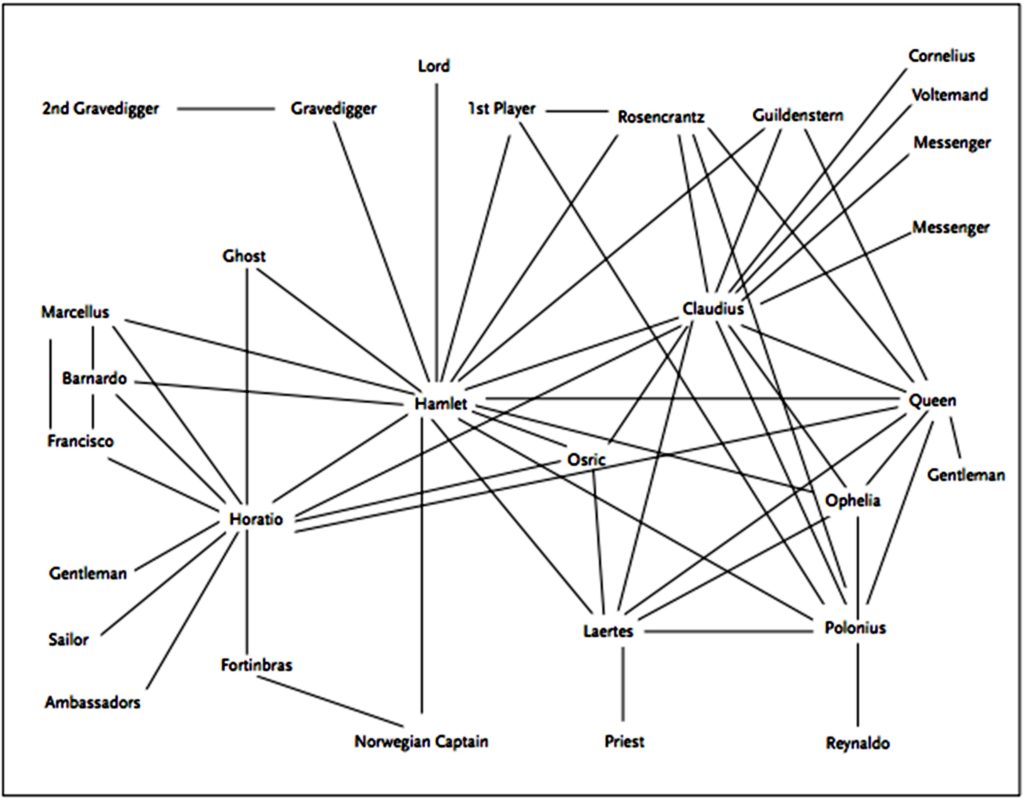
Networks/graphs are currently a very popular method of representation and an organisational principle in the fields of data modelling and (that is structured data which is interlinked with other data so it becomes more useful through semantic queries). They thus play a special role in DH and in digital scholarship at large (Weingart, 2011; Eide, 2020). There are many free, open-source options for generating network graphs, including Gephi, Palladio, NetworkX, igraph, and Cytoscape, as well as a number of network datasets, such as Stanford Large Network Dataset Collection and Gephi Datasets.
Not surprisingly, network is a crucial, multi-faceted keyword for all of us collaborating in the Congruence Engine project. From transportation routes, electrical and energy grids that facilitated industrialisation, telecommunication networks, broadcast radio and television networks, the modern industrial society has been shaped by a variety of networks. The Congruence Engine aims to investigate the (often hidden or unknown) technological, material, economic, cultural and social dimensions of modern industrial networks in the fields of Communication, Energy and Textiles, by focusing on the nodes and edges that enabled them, that is the material assets, the institutions and the agents behind them, thus revealing stories and connections among cultural assets across national industrial history collections.
Furthermore, being part of the AHRC-funded Towards a National Collection programme, the Congruence Engine will develop computationally-enabled ways to connect dispersed cultural assets and institutions, forming multiple, often unexpected, networks of collections-as-data. Through a series of digital experimentation exercises and interdisciplinary investigations, the project team will seek to develop a set of routes, digital tools and narratives that will allow advanced access, processing various objects and digital records from disparate collections. By employing advanced computational methods and relying on digital networks to interact, communicate and work, the project will seek to connect or reactivate these hidden histories with our recent socio-technical environment of interconnected nodes.
The Congruence Engine forms also an exceptionally rich and diverse network of people and institutions itself. It unites in close collaboration a new constellation of researchers and professionals from different fields and backgrounds who would not normally work together: academic, GLAM and community historians, curators, digital humanities professionals, documentation specialists, information architects and software engineers. Through a systemic and participatory action research methodology, and by welcoming from the outset various levels of engagement with the project among partners, collaborators and users, the Congruence Engine seeks to deliver a true inter- and multi-disciplinary investigation of complexity, while paying attention to the multiple networks, systems and agents at play.
Finally, the Congruence Engine celebrates both connectivity and difference as found within the multiple networks that it enables: from dispersed collections of the industrial past to various interdisciplinary groups of people. In the end, what brings together nodes and edges into a meaningful, functional whole as a network is a shared, primordial need to communicate and to be together.
Arran’s response
The word ‘network’ has the potential for diverse usage throughout the Congruence Engine. We are constantly interacting within networks – reaching out and communicating through networks of people and institutions, using technology that relies on networks to interact with colleagues and undertake our work, and, at the very core of the project and the Towards a National Collection programme, actively navigating and forming networks of collections data and knowledge. When I think about networks specifically from the view of my role as co-facilitator of the action research in this project, I am drawn to the role of networks in actively connecting different parts of a system.
As an action research project we are particularly interested in what is known as systemic action research; we are seeking to better understand the multiple social, political and digital systems at play within the context of the Congruence Engine, and the different networks that help make connections between the components in them. Systemic action research uses the core principles of action research, but makes a concerted effort to draw out and embrace complexity and systemic thinking (Burns, 2014). Referenced throughout the papers in this special issue, will be the interdisciplinary nature of this project, the need for a plurality of views, an expanded epistemology, and space for divergence as well as congruence. Whilst we do often seek consensus and standardisation, Gerald Midgley argues that it is in theoretical and methodological pluralism that the strength of systemic action research lies, and that in trying to essentialise or foundationalise certain theories or approaches, you diminish its potential (Midgley, 2011).
Amongst the pluralities of ways of working, theoretical framings and methodological approaches, we do have some shared goals in the project. I believe that it is through the active tending of our networks that we can come to develop shared understanding in our specific contexts. Yuha Jung and Ann Rowson Love offer a nice description of this in their work on systems thinking in museums – suggesting a wider shift towards valuing ‘networks of ideas’ over compartmentalisation (Jung and Love, 2017, p 4). We shouldn’t be aiming to end up on the same network node – having the same perspectives as each other, nor should we be working in distinct, siloed work packages. We should instead be seeking to communicate, respect and collaboratively explore our multiplicity of perspectives, and allow them to form networks as they cross over and intersect – providing us all with a slightly better overviews of the whole system.
Stefania’s response
As Anna-Maria has highlighted, ‘network’ has been an influential concept throughout human history: it has been used in a variety of different disciplines and has fostered a series of key organisational theories, acquiring further levels of meaning in our digital ecosystem. In the heritage sector, the concept of ‘museum network’ emerged in the 1990s to identify a specific management strategy with the primary aim of stimulating cooperation among cultural institutions which are drawn together by similarities in terms of geographical location, collections or shared values (Bagdadli, 2003; Camacho, 2004). One of the key areas of cooperation has been the development of promotional and communication strategies, with the creation of joint websites, social media activities, museum brochures and catalogues, and online collections. These projects have been pivotal in fostering transdisciplinary approaches and the exchange of practices, contributing to conceptualising the museum as a system of relationships.
However, I feel that the meaning that this word has acquired in the cultural sector does not fully capture the complexity of relationships that surround a museum institution. In the Museums of the Dolomites project, we ended up using the word ‘community’ to identify the coming together of people, institutions and local groups fostered by the digital initiatives. Participants felt that the word ‘network’ carried an institutional meaning which did not fully convey the bottom-up, dynamic, informal relationships between museum curators, researchers, amateurs, inhabitants and Dolomites aficionados. The participatory nature of the digital activities and the heterogeneity of the participants fostered a deeply humanised reinterpretation of the ‘network’ concept, that embraces the polyvocality and diversity of the participants.
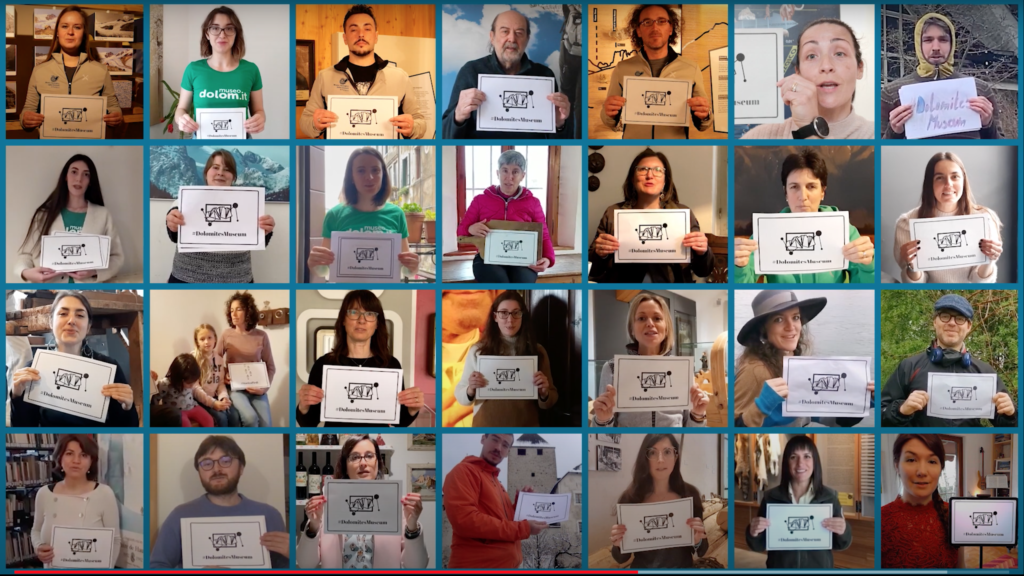
Similarly, this rethinking of the ‘network’ concept can help to express the multiplicity of relational levels that can emerge when we bring different collections together. In the textiles pilot study of Congruence Engine, we used the linking functionalities of the Omeka platform[16] to explore connections between objects, people, places, events and collections around the history of Saltaire and Lister Mill. What we realised at this early stage of the project, is that there could be different types of relationships. The first we explored is the direct, objective connection between two items, such as a textile machine and its inventor. The second is less visible as it might originate from a mental association that could involve feelings and personal experiences. This is a softer, evocative relationship that exists between a textile mill and the unremitting sound of the machines heard by the mill workers every day. I visualise the first type of connections as a network made of nodes connected together; the second with clouds of different colours which identify patterns, themes, feelings. I would love to see how we might expand the meaning of ‘network’ in Congruence Engine, exploring these different perspectives.
Closing thoughts
https://dx.doi.org/10.15180/221810/006Although too early to begin developing conclusions, we see the benefit of reflecting on the process of collaborating with each other to write in this way. The Congruence Engine is a large and geographically distributed project, and we rarely get the opportunity to meet and share ideas, theories and values in the way we have for this paper. In taking the opportunity, and the time, to share, communicate and write in this way we have developed a greater sense of each other’s roles and approaches to the research. The use of keywords and the opportunity to respond to each others’ contribution also allowed us to reflect on the terminology we use to describe concepts, phenomena and processes which might have assumed different meanings across a range of disciplines. Language diversity is a key challenge for interdisciplinary projects like Congruence Engine and expressing this semantic richness is fundamental to facilitate the exchange of knowledge across the research team. Whilst we cannot pin this paper down as the only cause, we think it is fair to claim that as we have been writing this paper together, our collaborations across the project have become more fluid, more natural and more impactful. We have perhaps understood better what resonates with each other, how we fit into the network of individuals who make up this project, and how we are a community of researchers in our own right. We look forward to further understanding how working productively with multiple perspectives can help drive the Congruence Engine and inform the requirements of developing a national collection.





